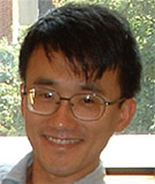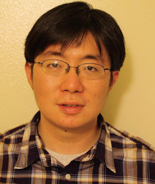|
Greetings: Professor Pei-Ming Ho won the 2011 AAA 2011, Volume 6, Number 4 |
|---|
Professor Pei-Ming Ho won the 2011 Achievement in Asia Award (AAA), and Prof. Cenke Xu won the 2011 Outstanding Young Researcher Award (OYRA) of the Overseas Chinese Physics Association (OCPA). The OCPA AAA Award is given annually to Chinese physicists working in Asia in recognition of their outstanding achievements in physics, and the OYRA Award is given annually to a physicist of Chinese ethnicity working in North America, Europe, or other regions outside Asia, to encourage and to recognize the young researcher’s contributions in physics.

Professor Pei-Ming Ho was born in Taipei, Taiwan, China, on August 1, 1967. He got his B.S. in Electrical Engineering at “National Taiwan University” in 1989, and after two years of military service, he went to University of California at Berkeley and received his Ph.D. in physics in 1996 under the supervision of Prof. Bruno Zumino. He was a postdoc at University of Utah before coming back to Taiwan in 1998 as an assistant professor of physics at National Taiwan University, where he was promoted a full professor six years later. He is currently a distinguished professor of the department, the director of the NTU Center for Theoretical Sciences, and the director of the Physics Division of National Center for Theoretical Sciences (North).
Professor Ho’s research interest lies in string theory. He worked on noncommutative D-brane field theories, AdS/CFT duality, multiple M2-brane theories and M5-brane theory, etc. Among his better known work is the erivation of noncommutative geometry on D-branes in B field backgrounds, in collaboration with Prof. Chong-Sun Chu at Durham University, with whom he also worked on many other topics over the years. More recently he and his collaborators Prof. Matsuo, Prof. Imamura and Dr. Shiba generalized the story of D-brane in B field background to M5-brane in C field background, and found a non-Abelian self-dual gauge field in six dimensions with supersymmetry.

Professor Cenke Xu received his bachelor’s degree from Tsinghua University in 2003. He received his Ph.D. from University of California, Berkeley in 2007. After that he joined the Society of Fellows, Harvard University as a Junior Fellow postdoctoral researcher. In 2009 he joined the Department of Physics, University of California at Santa Barbara as an assistant professor.
Professor Xu’s research has been focused on hard condensed matter theory, especially on strongly correlated systems, such as quantum spin liquid, high temperature superconductor, quantum criticality, etc. When he was in Harvard, Prof. Xu and his collaborator Prof. Subir Sachdev developed a theory for the interplay between lattice distortion, nematic order and spin density wave order in the iron–pnictides superconductors. This theory explains the different behaviors between two families of iron–pnictides materials, especially the nature of their phase transitions at finite temperature. He also developed a unified field theory for many frustrated magnet materials with a triangular lattice structure, and various different phases observed experimentally were obtained within this one single formalism, including the spin-liquid phases observed in organic material κ-(ET)2Cu2(CN)3 and EtMe3Sb[Pd(dmit)2]2. Professor Xu also proposed a lattice quantum boson model, whose ground state is a novel stable algebraic Bose liquid phase, and its low energy excitations have the same gauge symmetry and dispersion as the linearized Horava’s nonrelativistic quantum gravity theory. Most recently, Prof. Xu has been interested in quantum entanglement, and the physical effects of topological terms of nonlinear sigma models in dimensions higher than one.